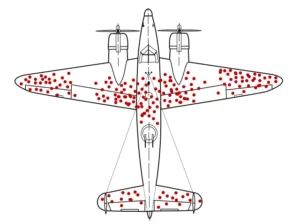

A “data fallacy” refers to a mistaken or misleading conclusion that arises from errors or misinterpretations related to data analysis. Data fallacies can occur at various stages of the data analysis process, including data collection, cleaning, processing, and interpretation. These fallacies can lead to incorrect insights, biased results, or flawed decision-making.
Consider this illustration from WWII

A team was tasked with determining the optimal locations to install armour on planes. Upon inspecting returning aircraft, they noticed bullet holes riddling every part of the planes except the engine and cockpit. Strangely, they concluded that reinforcing the areas untouched by bullets was paramount since planes struck in those untouched regions didn’t make it back.
This scenario exemplifies survivor bias, as the team overlooked the planes shot in critical zones and failed to return. Their decision was based solely on the survivors, ignoring the vital insight hidden within the fallen aircraft.
Survivor bias is a cognitive pitfall that arises when we focus only on the successful outcomes or survivors of a particular process while overlooking those that did not succeed or dropped out. This bias can distort our understanding of reality and lead to faulty conclusions, particularly in business, history, and statistics.
For instance, in the business world, survivor bias can occur when we analyse the characteristics of successful companies while neglecting those that failed, thus creating an incomplete picture of the factors contributing to success. Survivor bias can skew our perception of events in a historical context, as only the records of surviving artefacts, documents, or stories are available, obscuring the full extent of past circumstances.
To mitigate survivor bias, a comprehensive approach is necessary. This involves considering successes and failures and acknowledging the hidden insights within the stories of those who did not make it through.

Derived from a historical anecdote, the Cobra Effect materialises when an incentive for problem-solving inadvertently generates unfavourable outcomes. Legend states that during the 1800s, the British Empire sought to curb deaths from cobra bites in India. They initiated a monetary reward for each cobra skin submitted to stimulate cobra hunting. However, the result was unexpected: individuals commenced cultivating cobras instead. Recognising the counterproductive nature of the incentive, the government withdrew it, prompting cobra farmers to release their snakes and aggravating the population issue. This narrative underscores the importance of vigilance when designing incentives or objectives, as inadvertently fostering undesirable behaviours can lead to unintended and adverse consequences.
The Cobra Effect is a cautionary tale about the complexities of incentives and unintended outcomes. It highlights how well-intentioned actions can lead to negative results when the full scope of consequences is not considered. The term often illustrates instances where solutions backfire due to unforeseen reactions to incentives or interventions.

The gambler’s fallacy is a cognitive bias that occurs when an individual believes that past events in a random sequence will influence future outcomes, even when each event is statistically independent and unrelated to previous occurrences. This fallacy is rooted in a misconception about probability and randomness. People falling victim to the gambler’s fallacy might think that if a specific outcome, such as the flip of a coin landing on heads, has occurred multiple times in a row, the subsequent outcome is more likely to be the opposite, in this case, tails. This reasoning overlooks that each coin flip is an independent event with a 50% chance of heads or tails, regardless of past outcomes.
For example, imagine a person at a casino who has witnessed a roulette wheel landing on red for several spins in a row. They might erroneously believe that black is “due” to come up next, assuming that the wheel has to “balance out” the outcomes. This fallacy can lead individuals to make irrational decisions, from gambling to investing, by incorrectly assuming patterns or trends where none truly exist. In reality, random processes do not have memory, and each event’s outcome remains independent of previous events, making the gambler’s fallacy a misleading way to interpret and predict random outcomes.
A “data fallacy” refers to a mistaken or misleading conclusion that arises from errors or misinterpretations related to data analysis. Data fallacies can occur at various stages of the data analysis process, including data collection, cleaning, processing, and interpretation. These fallacies can lead to incorrect insights, biased results, or flawed decision-making.
Consider this illustration from WWII

A team was tasked with determining the optimal locations to install armour on planes. Upon inspecting returning aircraft, they noticed bullet holes riddling every part of the planes except the engine and cockpit. Strangely, they concluded that reinforcing the areas untouched by bullets was paramount since planes struck in those untouched regions didn’t make it back.
This scenario exemplifies survivor bias, as the team overlooked the planes shot in critical zones and failed to return. Their decision was based solely on the survivors, ignoring the vital insight hidden within the fallen aircraft.
Survivor bias is a cognitive pitfall that arises when we focus only on the successful outcomes or survivors of a particular process while overlooking those that did not succeed or dropped out. This bias can distort our understanding of reality and lead to faulty conclusions, particularly in business, history, and statistics.
For instance, in the business world, survivor bias can occur when we analyse the characteristics of successful companies while neglecting those that failed, thus creating an incomplete picture of the factors contributing to success. Survivor bias can skew our perception of events in a historical context, as only the records of surviving artefacts, documents, or stories are available, obscuring the full extent of past circumstances.
To mitigate survivor bias, a comprehensive approach is necessary. This involves considering successes and failures and acknowledging the hidden insights within the stories of those who did not make it through.

Derived from a historical anecdote, the Cobra Effect materialises when an incentive for problem-solving inadvertently generates unfavourable outcomes. Legend states that during the 1800s, the British Empire sought to curb deaths from cobra bites in India. They initiated a monetary reward for each cobra skin submitted to stimulate cobra hunting. However, the result was unexpected: individuals commenced cultivating cobras instead. Recognising the counterproductive nature of the incentive, the government withdrew it, prompting cobra farmers to release their snakes and aggravating the population issue. This narrative underscores the importance of vigilance when designing incentives or objectives, as inadvertently fostering undesirable behaviours can lead to unintended and adverse consequences.
The Cobra Effect is a cautionary tale about the complexities of incentives and unintended outcomes. It highlights how well-intentioned actions can lead to negative results when the full scope of consequences is not considered. The term often illustrates instances where solutions backfire due to unforeseen reactions to incentives or interventions.

The gambler’s fallacy is a cognitive bias that occurs when an individual believes that past events in a random sequence will influence future outcomes, even when each event is statistically independent and unrelated to previous occurrences. This fallacy is rooted in a misconception about probability and randomness. People falling victim to the gambler’s fallacy might think that if a specific outcome, such as the flip of a coin landing on heads, has occurred multiple times in a row, the subsequent outcome is more likely to be the opposite, in this case, tails. This reasoning overlooks that each coin flip is an independent event with a 50% chance of heads or tails, regardless of past outcomes.
For example, imagine a person at a casino who has witnessed a roulette wheel landing on red for several spins in a row. They might erroneously believe that black is “due” to come up next, assuming that the wheel has to “balance out” the outcomes. This fallacy can lead individuals to make irrational decisions, from gambling to investing, by incorrectly assuming patterns or trends where none truly exist. In reality, random processes do not have memory, and each event’s outcome remains independent of previous events, making the gambler’s fallacy a misleading way to interpret and predict random outcomes.


